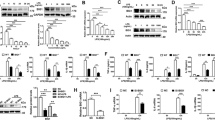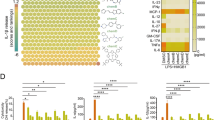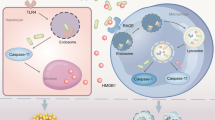Abstract
Sepsis, a hyperinflammatory response that can result in multiple organ dysfunctions, is a leading cause of mortality from infection. Here, we show that orphan nuclear receptor Nur77 (also known as TR3) can enhance resistance to lipopolysaccharide (LPS)-induced sepsis in mice by inhibiting NF-κB activity and suppressing aberrant cytokine production. Nur77 directly associates with p65 to block its binding to the κB element. However, this function of Nur77 is countered by the LPS-activated p38α phosphorylation of Nur77. Dampening the interaction between Nur77 and p38α would favor Nur77 suppression of the hyperinflammatory response. A compound, n-pentyl 2-[3,5-dihydroxy-2-(1-nonanoyl) phenyl]acetate, screened from a Nur77-biased library, blocked the Nur77-p38α interaction by targeting the ligand-binding domain of Nur77 and restored the suppression of the hyperinflammatory response through Nur77 inhibition of NF-κB. This study associates the nuclear receptor with immune homeostasis and implicates a new therapeutic strategy to treat hyperinflammatory responses by targeting a p38α substrate to modulate p38α-regulated functions.
This is a preview of subscription content, access via your institution
Access options
Subscribe to this journal
Receive 12 print issues and online access
$259.00 per year
only $21.58 per issue
Buy this article
- Purchase on Springer Link
- Instant access to full article PDF
Prices may be subject to local taxes which are calculated during checkout






Similar content being viewed by others
References
Lever, A. & Mackenzie, I. Sepsis: definition, epidemiology, and diagnosis. Br. Med. J. 335, 879–883 (2007).
Hartman, M.E., Linde-Zwirble, W.T., Angus, D.C. & Watson, R.S. Trends in the epidemiology of pediatric severe sepsis. Pediatr. Crit. Care Med. 14, 686–693 (2013).
Ulloa, L. & Tracey, K.J. The “cytokine profile”: a code for sepsis. Trends Mol. Med. 11, 56–63 (2005).
Beutler, B. & Rietschel, E.T. Innate immune sensing and its roots: the story of endotoxin. Nat. Rev. Immunol. 3, 169–176 (2003).
Akira, S. & Takeda, K. Toll-like receptor signalling. Nat. Rev. Immunol. 4, 499–511 (2004).
Han, J. & Ulevitch, R.J. Limiting inflammatory responses during activation of innate immunity. Nat. Immunol. 6, 1198–1205 (2005).
Hayden, M.S. & Ghosh, S. Signaling to NF-κB. Genes Dev. 18, 2195–2224 (2004).
Beyaert, R. et al. The p38/RK mitogen-activated protein kinase pathway regulates interleukin-6 synthesis response to tumor necrosis factor. EMBO J. 15, 1914–1923 (1996).
Vanden Berghe, W. et al. p38 and extracellular signal-regulated kinase mitogen-activated protein kinase pathways are required for nuclear factor-κB p65 transactivation mediated by tumor necrosis factor. J. Biol. Chem. 273, 3285–3290 (1998).
Ono, K. & Han, J. The p38 signal transduction pathway: activation and function. Cell. Signal. 12, 1–13 (2000).
Saha, R.N., Jana, M. & Pahan, K. MAPK p38 regulates transcriptional activity of NF-κB in primary human astrocytes via acetylation of p65. J. Immunol. 179, 7101–7109 (2007).
Hazel, T.G., Nathans, D. & Lau, L.F. A gene inducible by serum growth factors encodes a member of the steroid and thyroid hormone receptor superfamily. Proc. Natl. Acad. Sci. USA 85, 8444–8448 (1988).
Pei, L., Castrillo, A., Chen, M., Hoffmann, A. & Tontonoz, P. Induction of NR4A orphan nuclear receptor expression in macrophages in response to inflammatory stimuli. J. Biol. Chem. 280, 29256–29262 (2005).
Bonta, P.I. et al. Nuclear receptors Nur77, Nurr1, and NOR-1 expressed in atherosclerotic lesion macrophages reduce lipid loading and inflammatory responses. Arterioscler. Thromb. Vasc. Biol. 26, 2288–2294 (2006).
You, B., Jiang, Y.Y., Chen, S., Yan, G. & Sun, J. The orphan nuclear receptor Nur77 suppresses endothelial cell activation through induction of IκBα expression. Circ. Res. 104, 742–749 (2009).
Hamers, A.A. et al. Bone marrow–specific deficiency of nuclear receptor Nur77 enhances atherosclerosis. Circ. Res. 110, 428–438 (2012); erratum 110, e46 (2012).
Hanna, R.N. et al. NR4A1 (Nur77) deletion polarizes macrophages toward an inflammatory phenotype and increases atherosclerosis. Circ. Res. 110, 416–427 (2012).
Doi, K., Leelahavanichkul, A., Yuen, P.S. & Star, R.A. Animal models of sepsis and sepsis-induced kidney injury. J. Clin. Invest. 119, 2868–2878 (2009).
Litvak, V. et al. Function of C/EBPΔ in a regulatory circuit that discriminates between transient and persistent TLR4-induced signals. Nat. Immunol. 10, 437–443 (2009).
Tian, B., Nowak, D.E., Jamaluddin, M., Wang, S. & Brasier, A.R. Identification of direct genomic targets downstream of the nuclear factor-κB transcription factor mediating tumor necrosis factor signaling. J. Biol. Chem. 280, 17435–17448 (2005).
Németh, Z.H. et al. cDNA microarray analysis reveals a nuclear factor-κB–independent regulation of macrophage function by adenosine. J. Pharmacol. Exp. Ther. 306, 1042–1049 (2003).
Wang, H. et al. NF-κB regulation of YY1 inhibits skeletal myogenesis through transcriptional silencing of myofibrillar genes. Mol. Cell. Biol. 27, 4374–4387 (2007).
Alkalay, I. et al. Stimulation-dependent IκBα phosphorylation marks the NF-κB inhibitor for degradation via the ubiquitin-proteasome pathway. Proc. Natl. Acad. Sci. USA 92, 10599–10603 (1995).
Hong, C.Y. et al. Molecular mechanism of suppression of testicular steroidogenesis by proinflammatory cytokine tumor necrosis factor α. Mol. Cell. Biol. 24, 2593–2604 (2004).
Zhan, Y.Y. et al. The orphan nuclear receptor Nur77 regulates LKB1 localization and activates AMPK. Nat. Chem. Biol. 8, 897–904 (2012).
Kang, Y.J. et al. Macrophage deletion of p38α partially impairs lipopolysaccharide-induced cellular activation. J. Immunol. 180, 5075–5082 (2008).
Malek, S., Huxford, T. & Ghosh, G. IκBα functions through direct contacts with the nuclear localization signals and the DNA binding sequences of NF-κB. J. Biol. Chem. 273, 25427–25435 (1998).
Sun, S.C., Ganchi, P.A., Ballard, D.W. & Greene, W.C. NF-κB controls expression of inhibitor IκBα: evidence for an inducible autoregulatory pathway. Science 259, 1912–1915 (1993).
Arenzana-Seisdedos, F. et al. Nuclear localization of IκBα promotes active transport of NF-κB from the nucleus to the cytoplasm. J. Cell Sci. 110, 369–378 (1997).
Han, J., Lee, J.D., Bibbs, L. & Ulevitch, R.J.A. MAP kinase targeted by endotoxin and hyperosmolarity in mammalian cells. Science 265, 808–811 (1994).
Trempolec, N., Dave-Coll, N. & Nebreda, A.R. SnapShot: p38 MAPK substrates. Cell 152, 924–924 e1 (2013).
Liu, B. et al. Regulation of the orphan receptor TR3 nuclear functions by c-Jun N terminal kinase phosphorylation. Endocrinology 148, 34–44 (2007).
Wang, A., Rud, J., Olson, C.M. Jr., Anguita, J. & Osborne, B.A. Phosphorylation of Nur77 by the MEK-ERK-RSK cascade induces mitochondrial translocation and apoptosis in T cells. J. Immunol. 183, 3268–3277 (2009).
Chen, H.Z. et al. The orphan receptor TR3 suppresses intestinal tumorigenesis in mice by downregulating Wnt signalling. Gut 61, 714–724 (2012).
Liu, J.J. et al. A unique pharmacophore for activation of the nuclear orphan receptor Nur77 in vivo and in vitro. Cancer Res. 70, 3628–3637 (2010).
Wang, W.J. et al. Orphan nuclear receptor TR3 acts in autophagic cell death via mitochondrial signaling pathway. Nat. Chem. Biol. 10, 133–140 (2014).
Dogné, J.M., Supuran, C.T. & Pratico, D. Adverse cardiovascular effects of the coxibs. J. Med. Chem. 48, 2251–2257 (2005).
Mukherjee, D., Nissen, S.E. & Topol, E.J. Risk of cardiovascular events associated with selective COX-2 inhibitors. J. Am. Med. Assoc. 286, 954–959 (2001).
Dinarello, C.A. Anti-inflammatory agents: present and future. Cell 140, 935–950 (2010).
Peifer, C., Wagner, G. & Laufer, S. New approaches to the treatment of inflammatory disorders small molecule inhibitors of p38 MAP kinase. Curr. Top. Med. Chem. 6, 113–149 (2006).
Hynes, J. Jr. & Leftheri, K. Small molecule p38 inhibitors: novel structural features and advances from 2002–2005. Curr. Top. Med. Chem. 5, 967–985 (2005).
Pettus, L.H. & Wurz, R.P. Small molecule p38 MAP kinase inhibitors for the treatment of inflammatory diseases: novel structures and developments during 2006–2008. Curr. Top. Med. Chem. 8, 1452–1467 (2008).
Genovese, M.C. Inhibition of p38: has the fat lady sung? Arthritis Rheum. 60, 317–320 (2009).
Zhang, J., Shen, B. & Lin, A. Novel strategies for inhibition of the p38 MAPK pathway. Trends Pharmacol. Sci. 28, 286–295 (2007).
Goldstein, D.M. & Gabriel, T. Pathway to the clinic: inhibition of P38 MAP kinase. A review of ten chemotypes selected for development. Curr. Top. Med. Chem. 5, 1017–1029 (2005).
Davidson, W. et al. Discovery and characterization of a substrate selective p38αinhibitor. Biochemistry 43, 11658–11671 (2004).
Subramanian, A. et al. Gene set enrichment analysis: a knowledge-based approach for interpreting genome-wide expression profiles. Proc. Natl. Acad. Sci. USA 102, 15545–15550 (2005).
McCoy, A.J. et al. Phaser crystallographic software. J. Appl. Crystallogr. 40, 658–674 (2007).
Emsley, P., Lohkamp, B., Scott, W.G. & Cowtan, K. Features and development of Coot. Acta Crystallogr. D Biol. Crystallogr. 66, 486–501 (2010).
Collaborative Computational Project, Number 4. The CCP4 suite: programs for protein crystallography. Acta Crystallogr. D Biol. Crystallogr. 50, 760–763 (1994).
Murshudov, G.N. et al. REFMAC5 for the refinement of macromolecular crystal structures. Acta Crystallogr. D Biol. Crystallogr. 67, 355–367 (2011).
Murshudov, G.N., Vagin, A.A. & Dodson, E.J. Refinement of macromolecular structures by the maximum-likelihood method. Acta Crystallogr. D Biol. Crystallogr. 53, 240–255 (1997).
Cogan, U., Kopelman, M., Mokady, S. & Shinitzky, M. Binding affinities of retinol and related compounds to retinol binding proteins. Eur. J. Biochem. 65, 71–78 (1976).
Chen, R., Li, L. & Weng, Z. ZDOCK: an initial-stage protein-docking algorithm. Proteins 52, 80–87 (2003).
Li, L., Chen, R. & Weng, Z. RDOCK: refinement of rigid-body protein docking predictions. Proteins 53, 693–707 (2003).
Brooks, B.R. et al. Charmm—a program for macromolecular energy, minimization, and dynamics calculations. J. Comput. Chem. 4, 187–217 (1983).
Banks, J.L. et al. Integrated modeling program, applied chemical theory (IMPACT). J. Comput. Chem. 26, 1752–1780 (2005).
Shivakumar, D. et al. Prediction of absolute solvation free energies using molecular dynamics free energy perturbation and the OPLS force field. J. Chem. Theory Comput. 6, 1509–1519 (2010).
Acknowledgements
This work was supported by grants from the National Natural Science Fund of China, the '973' Project of the Ministry of Science and Technology (91413113, 2014CB910602, 31370724, 31221065) and the Program of Introducing Talents of Discipline to Universities (B12001). The crystallographic data collection at Beamline BL17U1 at Shanghai Synchrotron Radiation Facility is gratefully acknowledged.
Author information
Authors and Affiliations
Contributions
The Wu laboratory (L.L., Y.L., H.C., J. He, Y.X., Y.C. and W.W.) was responsible for the experiments on molecular cellular biology and detection in mice. The Lin laboratory (F.L., X.T., A.L., Q.Z.) was responsible for the structure determination and analysis. The Han laboratory (J.W.) provided p38αfl/fl and LtrLysCre-p38αΔ/Δ mice. The Huang laboratory (H.Z.) provided the compounds. J. Han was involved in the discussion of the manuscript. Q.W. and T.L. designed the experiments and wrote the manuscript.
Corresponding authors
Ethics declarations
Competing interests
The authors declare no competing financial interests.
Supplementary information
Supplementary Text and Figures
Supplementary Results, Supplementary Figures 1–8 and Supplementary Tables 1–4. (PDF 17762 kb)
Rights and permissions
About this article
Cite this article
Li, L., Liu, Y., Chen, Hz. et al. Impeding the interaction between Nur77 and p38 reduces LPS-induced inflammation. Nat Chem Biol 11, 339–346 (2015). https://doi.org/10.1038/nchembio.1788
Received:
Accepted:
Published:
Issue Date:
DOI: https://doi.org/10.1038/nchembio.1788
This article is cited by
-
Nr4a1 promotes renal interstitial fibrosis by regulating the p38 MAPK phosphorylation
Molecular Medicine (2023)
-
Bioactive fraction from Plumeria obtusa L. attenuates LPS-induced acute lung injury in mice and inflammation in RAW 264.7 macrophages: LC/QToF-MS and molecular docking
Inflammopharmacology (2023)
-
Quantitative proteomics reveals protein dysregulation during T cell activation in multiple sclerosis patients compared to healthy controls
Clinical Proteomics (2022)
-
HK1 from hepatic stellate cell–derived extracellular vesicles promotes progression of hepatocellular carcinoma
Nature Metabolism (2022)
-
Prostaglandin A2 Interacts with Nurr1 and Ameliorates Behavioral Deficits in Parkinson’s Disease Fly Model
NeuroMolecular Medicine (2022)



